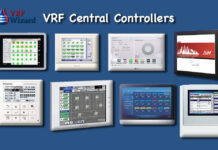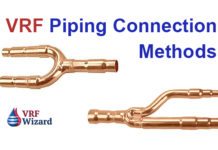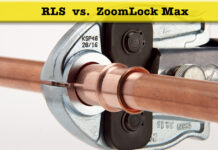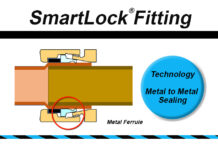VRF Heat Recovery System
Using a VRF Heat Recovery system allows you to provide simultaneous cooling and heating. This means that one zone can be in cooling mode while another is in heating. This is not possible with a VRF heat pump system. This is accomplished with the addition of a Branch Selector Box, which is the traffic cop of the refrigerant. The Branch Selector Box is located between the outdoor unit and the indoor unit.
VRF Manufactures Selector Box Names
Each VRF manufacture uses a different name to describe this box. Daikin calls theirs the
Branch Selector Box which is the name we have chosen to use through this presentation, the other VRF manufacture names for the branch selector box, include;
- Mitsubishi’s BC Controller (Branch Circuit Controller)
- Toshiba FS Unit (Flow Selector Unit)
- Fujitsu RB (Refrigerant Branch Unit)
- Hitachi COB (Change Over Box)
- Daikin BS (Branch Selector Box)
VRF Single-Port and Multi-Port Branch Selector Box
The VRF branch selector box can be a single-port box or a multi-port box. The easiest way to think of a branch port is that each port is a zone or area that has a similar heating and cooling load profiles. If you’re familiar with a VAV system, then each port is similar to a VAV Zone box, except that we are using refrigerant at the zone level instead of cooled air from an air handler.
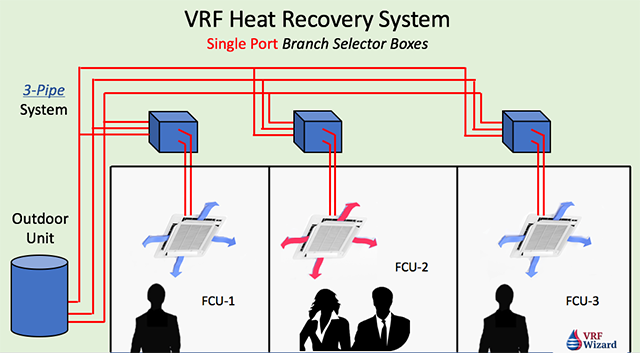
A VRF single port branch selector box gives you one zone where you can attach multiple indoor units, much like an air diffuser on a VAV system.
The VRF multi-port branch selector box allows multiple zones where each zone can decide whether to be in the cooling or heating mode in a VRF Heat Recovery System.
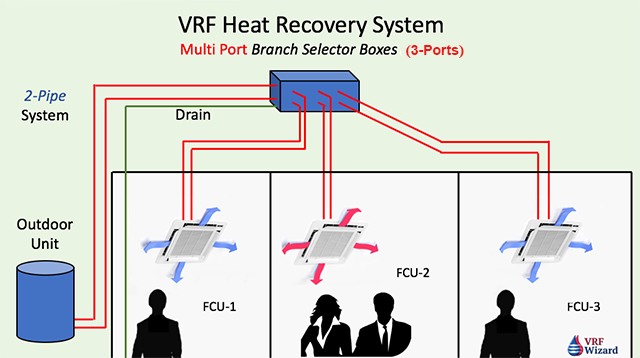

Each manufacture provides differing quantities of ports on their multi-port branch selector boxes, anywhere from 2 ports to 12 ports, with the ability to tie several boxes together to expand the capabilities.
Each port can serve a manufacture defined quantity of indoor units that will all share the same mode of operation, that’s either heating or cooling. Each port can deliver either heating or cooling, so put all of the same type of thermal profile rooms on the same port if so desired.
VRF Branch Selector Box Capacity (MBH)
Each port in a VRF Heat Recovery System Branch Selector Box is also rated for a maximum amount of BTU’s. So, let’s say that the manufacture states that each port can deliver a maximum of 54,000 btu’s. If you have a zone that is larger than that, then you can combine more than one port together to achieve the total BTU’s you are trying to achieve, or you can provide multiple Indoor Units using separate ports for each to feed the same zone. The Branch Selector Box also has a maximum amount of BTU’s that it’s capable of delivering. See VRF Manufacture Comparison.
VRF 2-Pipe versus 3-Pipe Systems
The other item of interest is the controversy over 2-pipe versus 3-pipe systems. Each VRF manufacture will say that their system is better than the competitions system. A VRF two-pipe system uses only 2 pipes that run between the outdoor unit and the indoor unit, while other manufactures use 3 pipes.
Although it would seem that the VRF 2-pipe system would save you material and labor cost, the other fact not mentioned when manufactures tout their 2-pipe system is that there Branch Selector Box needs a condensate drain line where as the 3-pipe system doesn’t, hence their 2-pipe VRF system has a third pipe, it’s just not a refrigerant pipe, but a condensate one, so in effect a VRF two-pipe system is a VRF three-pipe system of a different type.
The advantage of the VRF Heat Recovery System is that it allows simultaneous heating and cooling where as a Heat pump system doesn’t.
For a comparison of VRF Heat Recovery Systems between VRF Manufacturers, including maximum quantity of ports, capacity per port, and who has a VRF two-pipe system versus a VRF three-pipe system, and much more see our article on VRF Manufacture Comparison.
Watch the VRF VRV Heat Recovery System Video.
What experience have you had with VRF Heat Recovery systems and either single-port or multi-port branch selector boxes? Leave us a comment below.


